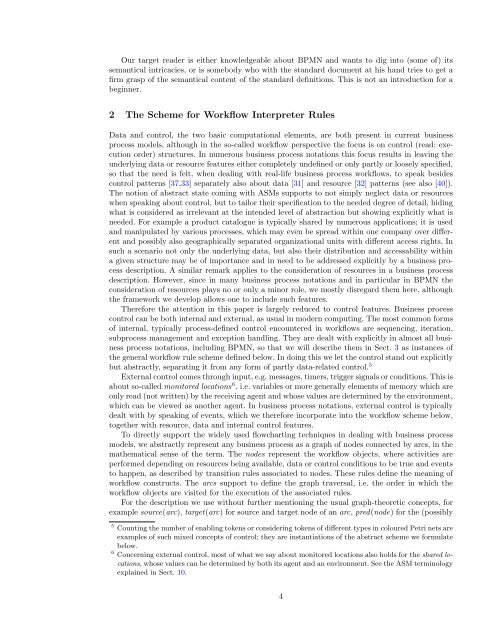BPMN and Beyond Business process modelling notation, workflow ...
BPMN and Beyond Business process modelling notation, workflow ...
BPMN and Beyond Business process modelling notation, workflow ...
Create successful ePaper yourself
Turn your PDF publications into a flip-book with our unique Google optimized e-Paper software.
Our target reader is either knowledgeable about <strong>BPMN</strong> <strong>and</strong> wants to dig into (some of) its<br />
semantical intricacies, or is somebody who with the st<strong>and</strong>ard document at his h<strong>and</strong> tries to get a<br />
firm grasp of the semantical content of the st<strong>and</strong>ard definitions. This is not an introduction for a<br />
beginner.<br />
2 The Scheme for Workflow Interpreter Rules<br />
Data <strong>and</strong> control, the two basic computational elements, are both present in current business<br />
<strong>process</strong> models, although in the so-called <strong>workflow</strong> perspective the focus is on control (read: execution<br />
order) structures. In numerous business <strong>process</strong> <strong>notation</strong>s this focus results in leaving the<br />
underlying data or resource features either completely undefined or only partly or loosely specified,<br />
so that the need is felt, when dealing with real-life business <strong>process</strong> <strong>workflow</strong>s, to speak besides<br />
control patterns [37,33] separately also about data [31] <strong>and</strong> resource [32] patterns (see also [40]).<br />
The notion of abstract state coming with ASMs supports to not simply neglect data or resources<br />
when speaking about control, but to tailor their specification to the needed degree of detail, hiding<br />
what is considered as irrelevant at the intended level of abstraction but showing explicitly what is<br />
needed. For example a product catalogue is typically shared by numerous applications; it is used<br />
<strong>and</strong> manipulated by various <strong>process</strong>es, which may even be spread within one company over different<br />
<strong>and</strong> possibly also geographically separated organizational units with different access rights. In<br />
such a scenario not only the underlying data, but also their distribution <strong>and</strong> accessability within<br />
a given structure may be of importance <strong>and</strong> in need to be addressed explicitly by a business <strong>process</strong><br />
description. A similar remark applies to the consideration of resources in a business <strong>process</strong><br />
description. However, since in many business <strong>process</strong> <strong>notation</strong>s <strong>and</strong> in particular in <strong>BPMN</strong> the<br />
consideration of resources plays no or only a minor role, we mostly disregard them here, although<br />
the framework we develop allows one to include such features.<br />
Therefore the attention in this paper is largely reduced to control features. <strong>Business</strong> <strong>process</strong><br />
control can be both internal <strong>and</strong> external, as usual in modern computing. The most common forms<br />
of internal, typically <strong>process</strong>-defined control encountered in <strong>workflow</strong>s are sequencing, iteration,<br />
sub<strong>process</strong> management <strong>and</strong> exception h<strong>and</strong>ling. They are dealt with explicitly in almost all business<br />
<strong>process</strong> <strong>notation</strong>s, including <strong>BPMN</strong>, so that we will describe them in Sect. 3 as instances of<br />
the general <strong>workflow</strong> rule scheme defined below. In doing this we let the control st<strong>and</strong> out explicitly<br />
but abstractly, separating it from any form of partly data-related control. 5<br />
External control comes through input, e.g. messages, timers, trigger signals or conditions. This is<br />
about so-called monitored locations 6 , i.e. variables or more generally elements of memory which are<br />
only read (not written) by the receiving agent <strong>and</strong> whose values are determined by the environment,<br />
which can be viewed as another agent. In business <strong>process</strong> <strong>notation</strong>s, external control is typically<br />
dealt with by speaking of events, which we therefore incorporate into the <strong>workflow</strong> scheme below,<br />
together with resource, data <strong>and</strong> internal control features.<br />
To directly support the widely used flowcharting techniques in dealing with business <strong>process</strong><br />
models, we abstractly represent any business <strong>process</strong> as a graph of nodes connected by arcs, in the<br />
mathematical sense of the term. The nodes represent the <strong>workflow</strong> objects, where activities are<br />
performed depending on resources being available, data or control conditions to be true <strong>and</strong> events<br />
to happen, as described by transition rules associated to nodes. These rules define the meaning of<br />
<strong>workflow</strong> constructs. The arcs support to define the graph traversal, i.e. the order in which the<br />
<strong>workflow</strong> objects are visited for the execution of the associated rules.<br />
For the description we use without further mentioning the usual graph-theoretic concepts, for<br />
example source(arc), target(arc) for source <strong>and</strong> target node of an arc, pred(node) for the (possibly<br />
5 Counting the number of enabling tokens or considering tokens of different types in coloured Petri nets are<br />
examples of such mixed concepts of control; they are instantiations of the abstract scheme we formulate<br />
below.<br />
6 Concerning external control, most of what we say about monitored locations also holds for the shared locations,<br />
whose values can be determined by both its agent <strong>and</strong> an environment. See the ASM terminology<br />
explained in Sect. 10.<br />
4
















